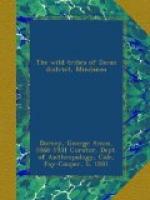Usually, the body is buried in the ground at a distance from the house. The coffin is made out of a split log, in which weapons, jars, and the like are placed for the use of the spirit. If the dead man has been a warrior he is dressed in the clothing distinctive of his rank, and his grave is covered with red flowers. At times the coffins are shaped to resemble small boats and are then placed on high poles near to the beach.
For a month following a funeral the relatives refrain from all merrymaking. At the expiration of this period all go to a near-by river and with their knives, cut to pieces a braided cord, which has been made since the burial, and as they destroy it they shout “This is a man we are killing. This is a man we are killing.” Finally, the pieces are thrown into the river and the period of taboo is past.
IV. TAGAKAOLO.
SYNONYMS.
(a) TAGAKAOLA.
(b) SAKA—“head of the river.”
(c) KAGAN, KALAGAN, CALAGANES, CALAGARS.
(d) LAOC. According to the account of PASTELL,[1] this name is given to a small, degraded division of the Tagakaolo who live in the mountains of Haguimitan on San Augustin peninsula.
[1] BLAIR and ROBERTSON, Vol. XLIII, p. 259.
The present habitat and general condition of this tribe is nearly the same as that of the Kulaman.
Prior to Spanish times they held the hill region back of the coast, between Malalag and Lais. On the Gulf side they were barred from the sea by the Kulaman and Moro, while in the mountains they encountered the powerful Bila-an tribe.
About fifty years ago that part of the tribe living furthest to the north united under the leadership of a brave warrior named Paugok, and made war on the Bagobo. They were successful in this conflict and drove their enemies from the rich valleys of the Padada and Bulatakay rivers, where they established themselves. This brought them in close contact with the Kulaman and Moro of the coast, with whom they lived on friendly terms. The influence of the latter group was so great that the newcomers not only adopted their style of dress, but also substituted cotton for hemp in the manufacture of their garments. Today the members of this tribe can still be recognized by their close fitting suits of red and yellow striped cloth, from which they have received the name of Kagan.[2] They have also been constant borrowers, from all their neighbors, of ideas for house-building and utensils. They have intermarried to some extent with the Kulaman, and in times past Bila-an and Bagobo slave women have been added to the tribe.
[2] The general name applied to red cotton trade cloth.
Today practically all the members of the Kagan division are found living on the American plantations along the Padada and Bulatakay rivers. They are on friendly terms with their Tagakaolo kinsmen, and are still so like them in language, social customs, and religious beliefs, that one description will suffice for both.




